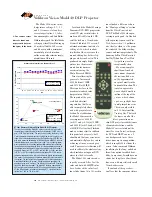
The Model 40 has five color-
temperature settings: 0, 1, 2, 3,
and 4. Of course, it also offers
several aspect ratios: 4:3, letter-
box, anamorphic, and Intelliwide.
Vidikron designed the Intelliwide
setting specifically for blowing up
4:3 material to fill a 16:9 screen,
and it does so with a minimum
amount of picture distortion,
unlike many other similar imple-
mentations of this sort.
I evaluated the Model 40 using a
Panasonic DVD-RP91 progressive-
scan DVD player in interlaced
mode and Dish Network’s HD
satellite feed on a 72-inch-wide
Stewart Studiotek 130 screen. I
obtained maximum contrast at a
setting of +18, which is about
two-thirds of the way across the
menu’s sliding bar, before clip-
ping or white crush set in. This
produced an amply bright
picture (see the measure-
ments box for our mea-
surements using the
Photo Research PR650).
Prior to calibrating the
gray scale, I measured
6,150 Kelvin at 30 IRE
and 5,975 K at 80 IRE.
This is quite close to the
broadcast-standard color
temperature of D6500.
The top end of the gray
scale had a distinct
magenta hue that I was
able to completely elimi-
nate with gray-scale cali-
bration. Post-calibration,
the Model 40 measured a
very impressive 6,500 K
(x=0.313 and y=0.328) at 30 IRE
and 6,450 K (x=0.314 and y=0.327)
at 80 IRE. It’s clear that Vidikron
made a serious effort to calibrate
this projector’s gray scale, but I
should note that your screen size
and material will play a key role in
achieving a linear, accurate gray
scale. Your service technician will
need to calibrate the whole system,
which includes using your DVD
player for the best results.
The Model 40’s color decoder
is pretty accurate. After I set the
color and tint with SMPTE color
bars, I reduced the color level
four clicks (from 34 to 30), as skin
tones looked a little too red on
the “Montage of Images” section
from the
Video Essentials
test
DVD. The Model 40’s video pro-
cessing is quite good. As I looked
at the opening sequence of
Star
Trek: Insurrection
, 3:2 pulldown
was clearly evident, as the projec-
tor rendered the bridge railing,
canoes, and rooftops pristinely. The
bouncing ball in
Video Essentials
’
Snell & Wilcox Zone Test Plate
test pattern was also
exceptionally clean.
My review sample’s
short-throw lens had
some minor chromatic
aberrations. Red was
out by approximately
one pixel, mostly in the
horizontal direction. The
lens also appeared to
have a slight barrel dis-
tortion at the top of the
picture, which shows
up as a very slight hori-
zontal pincushion error.
This was only visible
on 2.35:1 material like
Training Day
. That said,
the lenses on all of the
latest-generation one-
chip DLP projectors exhibit some
chromatic aberrations, and the
Model 40’s are certainly not the
worst I’ve seen. In fact, with regu-
lar DVD and HDTV sources, I
was hard-pressed to see these
issues from my viewing position,
which is roughly 10 feet from the
screen. I also commend Vidikron
for offering both a long- and short-
throw lens option for added flexi-
bility. In my room, I would have no
choice but to opt for a short-throw
lens, even with my relatively small
72-inch-wide screen.
If you look at the spec sheet,
you’ll see that the company claims
Vidikron Vision Model 40 DLP Projector
G E A R G U I D E
112
Home Theater /
November 2003 •
www.hometheatermag.com
C.
The remote offers
discrete input and
aspect-ratio buttons
that glow in the dark.
5000
5500
6000
6500
7000
20
30
35
40
45
50
55
60
65
70
75
80
85
90
95 100
IRE
Color Temp - Before
Color Temp - After
Color Temperature
Blue
Green
Red
Vidikron Red
Vidikron Green
Vidikron Blue
D6500 K
0
0.1
0.2
0.3
0.4
0.5
0.6
0.7
0.1
0.2
0.3
0.4
0.5
0.6
0.7
DTV Phosphors
D6500
Color Temp - Before
Color Temp - After
HT Labs Measures: Vidikron Vision Model 40 DLP Projector
The top chart shows the Model 40’s gray scale relative to its color
temperature at various levels of intensity, or brightness (20 IRE is dark
gray; 100 IRE is bright white). The gray scale as set by the factory, in the
2 color-temperature mode, measures slightly blue across the gray-scale
range. After making adjustments using the Photo Research PR-650, the
gray scale measures extremely well, within 80 Kelvin of D6500, the accu-
rate color temperature, across the entire range. This is a slight improve-
ment compared with the already-good performance before calibration.
The bottom chart shows the gray scale (or color temperature) relative to
the color points of the display’s red, green, and blue color-filter-wheel
segments. Green (x=0.311, y=0.574), red (x=0.656, y=0.338), and blue
(x=0.144, y=0.070) are slightly off those specified by SMPTE. Green is
somewhat undersaturated, while red and blue are slightly oversaturated.
This means that the display will reproduce most of the colors available in
the system. The light output was approximately 13 foot-lamberts (on a
6-foot-wide Studiotek 130 screen). A brighter image is possible at the
expense of gray-scale accuracy. The display has excellent DC restora-
tion and a good color decoder. The Model 40 displays approximately
480 lines (per picture height) with NTSC sources and, using our Leader
LT-446 HD generator, is capable of resolving DTV signals out to the
limits of the 1,280-by-720 chip.
—GM
Vidikron Vision Model 40 DLP Projector
Color Temperature
C





















